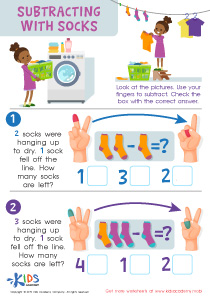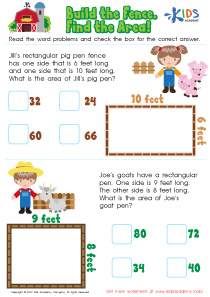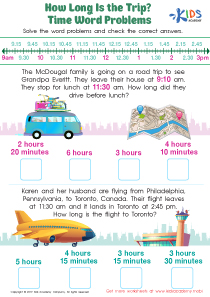Length and Mass Word Problems Worksheets for Ages 4-5
1 filtered results
-
From - To
Explore our engaging Length and Mass Word Problems worksheets, crafted specifically for children aged 4-5 years. These Homeschool worksheets offer a fun and interactive way to introduce young learners to the basics of measuring length and weight through relatable scenarios and colorful illustrations. Each worksheet is designed to enhance problem-solving skills and foundational math concepts with easy-to-understand problems suited for preschoolers. Whether used in a classroom setting or for homeschooling, these worksheets are perfect for fostering a love for learning and measurement in young minds. Jumpstart your child's education journey with our comprehensive and educational worksheets today!


Length Word Problems Worksheet
Worksheets on Length and Mass Word Problems provide a critical foundation for young learners, particularly those in the formative ages of 4 to 5 years. Incorporating Homeschool printables into early education offers numerous benefits, enhancing a child's ability to perceive, understand, and manipulate basic concepts of measurements in a concrete and engaging way. Here's a closer look at why these resources are particularly useful and how they can enrich a young child's learning journey.
1. Introduction to Quantitative Concepts
At ages 4 to 5, children are just beginning to understand the world in more quantitative terms. Homeschool printables focusing on length and mass introduce these concepts through visual, tactile, and verbal teaching methods. Worksheets designed with bright colors, engaging characters, and simple, relatable scenarios can help young learners grasp the basics of measuring length (like comparing the heights of two flowers or the lengths of different pencils) and mass (such as weighing fruits or small toys). These early introductions pave the way for more advanced mathematical and scientific thinking.
2. Development of Problem-Solving Skills
Length and Mass Word Problems worksheets challenge children to apply their observational skills to solve problems. Even at a young age, children can start to use critical thinking to decide which object is heavier or which is taller. Through guided problems on homeschool printables, children learn to analyze situations, compare results, and come up with answers, all within a safe learning environment that encourages trial and error.
3. Enhancement of Language and Reading Skills
Although primarily focused on math and science concepts, working with word problems also advances language skills. Children must read or listen to the description of the problem, process the information, and understand what is being asked. This practice not only builds their vocabulary but also enhances their comprehension skills, crucial for all areas of learning.
4. Encouraging Real-World Connections
One of the great benefits of using worksheets on Length and Mass is their ability to connect classroom learning with real-world applications. Homeschool printables can be designed to include scenarios that children might encounter in their daily lives, such as baking (measuring ingredients), playing at the park (comparing the height of slides), or helping with grocery shopping (weighing fruits and vegetables). These connections help solidify understanding and show children the practical importance of what they are learning.
5. Tailored Learning Experience
Homeschooling allows for a tailored educational experience, and printables can be specifically chosen or designed to align with each child's learning pace and interests. Worksheets on Length and Mass can be adjusted for complexity, incorporating more or fewer visual aids, depending on the child's proficiency and confidence with the material. For example, for a child fascinated by animals, problems might involve measuring and comparing the lengths of different animal tracks or the weights of various pet foods. Such customization keeps learning relevant and engaging, increasing the child’s motivation and enjoyment.
6. Preparation for Future Academic Success
Early exposure to structured mathematical problems like those found in length and mass worksheets can play a pivotal role in preparing children for formal schooling. These worksheets lay the groundwork for topics in geometry, algebra, and physics, by introducing the fundamental skills needed for more advanced studies. Moreover, mastering these basic concepts early on can boost a child's confidence in their mathematical abilities, encouraging a positive attitude towards learning and problem-solving in future academic endeavors.
7. Support for Parental Involvement
Homeschool printables provide an excellent opportunity for parents to get involved in their children's early education. Working together on Length and Mass Word Problems can foster a collaborative learning atmosphere where parents can observe directly their child's strengths and areas for improvement. This close involvement allows parents to provide immediate feedback and reinforcement, which is critical at this developmental stage. Additionally, it helps build a nurturing learning relationship where children feel supported and encouraged to explore and ask questions.
8. Fun and Interactive Learning
Finally, it’s important to remember that learning should be fun, especially at the early childhood stage. Worksheets on length and mass often include interactive elements such as cutting out measurement tools or using stickers to mark weights, which makes the learning process dynamic and enjoyable. These fun activities help keep young learners engaged and eager to explore new concepts without the pressure of traditional testing.
Conclusion
Utilizing Homeschool printables for teaching Length and Mass Word Problems offers a multitude of benefits for children aged 4 to 5. These resources not only introduce essential mathematical and scientific concepts but also enhance cognitive development, language skills, and practical understanding, all while keeping learning personalized and enjoyable. By integrating these worksheets into their curriculum, homeschooling parents can provide their children with a strong foundation that supports academic success and lifelong curiosity.

 Assign to the classroom
Assign to the classroom





